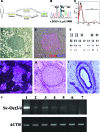Integration-free induced pluripotent stem cells derived from retinitis pigmentosa patient for disease modeling
- PMID: 23197854
- PMCID: PMC3659711
- DOI: 10.5966/sctm.2012-0005
Integration-free induced pluripotent stem cells derived from retinitis pigmentosa patient for disease modeling
Abstract
We investigated retinitis pigmentosa (RP) caused by a mutation in the gene rhodopsin (RHO) with a patient-specific rod cell model generated from induced pluripotent stem cells (iPSCs) derived from an RP patient. To generate the iPSCs and to avoid the unpredictable side effects associated with retrovirus integration at random loci in the host genome, a nonintegrating Sendai-virus vector was installed with four key reprogramming gene factors (POU5F1, SOX2, KLF4, and c-MYC) in skin cells from an RP patient. Subsequent selection of the iPSC lines was on the basis of karyotype analysis as well as in vitro and in vivo pluripotency tests. Using a serum-free, chemically defined, and stepwise differentiation method, the expressions of specific markers were sequentially induced in a neural retinal progenitor, a retinal pigment epithelial (RPE) progenitor, a photoreceptor precursor, RPE cells, and photoreceptor cells. In the differentiated rod cells, diffused distribution of RHO protein in cytoplasm and expressions of endoplasmic reticulum (ER) stress markers strongly indicated the involvement of ER stress. Furthermore, the rod cell numbers decreased significantly after successive culture, suggesting an in vitro model of rod degeneration. Thus, from integration-free patient-specific iPSCs, RP patient-specific rod cells were generated in vitro that recapitulated the disease feature and revealed evidence of ER stress in this patient, demonstrating its utility for disease modeling in vitro.
Figures





Similar articles
-
Robust and highly efficient hiPSC generation from patient non-mobilized peripheral blood-derived CD34+ cells using the auto-erasable Sendai virus vector.Stem Cell Res Ther. 2019 Jun 24;10(1):185. doi: 10.1186/s13287-019-1273-2. Stem Cell Res Ther. 2019. PMID: 31234949 Free PMC article.
-
Derivation, characterization and retinal differentiation of induced pluripotent stem cells.J Biosci. 2013 Mar;38(1):123-34. doi: 10.1007/s12038-012-9296-1. J Biosci. 2013. PMID: 23385820
-
High-efficiency generation of induced pluripotent mesenchymal stem cells from human dermal fibroblasts using recombinant proteins.Stem Cell Res Ther. 2016 Jul 30;7(1):99. doi: 10.1186/s13287-016-0358-4. Stem Cell Res Ther. 2016. PMID: 27473118 Free PMC article.
-
Choices for Induction of Pluripotency: Recent Developments in Human Induced Pluripotent Stem Cell Reprogramming Strategies.Stem Cell Rev Rep. 2016 Feb;12(1):54-72. doi: 10.1007/s12015-015-9622-8. Stem Cell Rev Rep. 2016. PMID: 26424535 Free PMC article. Review.
-
Methods of Generation of Induced Pluripotent Stem Cells and Their Application for the Therapy of Central Nervous System Diseases.Bull Exp Biol Med. 2020 Feb;168(4):566-573. doi: 10.1007/s10517-020-04754-4. Epub 2020 Mar 10. Bull Exp Biol Med. 2020. PMID: 32157511 Review.
Cited by
-
Probing disorders of the nervous system using reprogramming approaches.EMBO J. 2015 Jun 3;34(11):1456-77. doi: 10.15252/embj.201591267. Epub 2015 Apr 29. EMBO J. 2015. PMID: 25925386 Free PMC article. Review.
-
Reproducibility and staging of 3D human retinal organoids across multiple pluripotent stem cell lines.Development. 2019 Jan 9;146(1):dev171686. doi: 10.1242/dev.171686. Development. 2019. PMID: 30567931 Free PMC article.
-
Induced pluripotent stem cell potential in medicine, specifically focused on reproductive medicine.Front Surg. 2014 Mar 24;1:5. doi: 10.3389/fsurg.2014.00005. eCollection 2014. Front Surg. 2014. PMID: 25671222 Free PMC article. Review.
-
Characterization of human induced pluripotent stem cell-derived retinal pigment epithelium cell sheets aiming for clinical application.Stem Cell Reports. 2014 Jan 23;2(2):205-18. doi: 10.1016/j.stemcr.2013.12.007. eCollection 2014 Feb 11. Stem Cell Reports. 2014. PMID: 24527394 Free PMC article.
-
Unraveling the mysteries of pre-mRNA splicing in the retina via stem cell technology.Stem Cell Investig. 2016 Nov 4;3:72. doi: 10.21037/sci.2016.10.05. eCollection 2016. Stem Cell Investig. 2016. PMID: 27868054 Free PMC article. No abstract available.
References
-
- Boucherie C, Sowden JC, Ali RR. Induced pluripotent stem cell technology for generating photoreceptors. Regen Med. 2011;6:469–479. - PubMed
-
- Rowland TJ, Buchholz DE, Clegg DO. Pluripotent human stem cells for the treatment of retinal disease. J Cell Physiol. 2012;227:457–466. - PubMed
-
- Osakada F, Hirami Y, Takahashi M. Stem cell biology and cell transplantation therapy in the retina. Biotechnol Genet Eng Rev. 2010;26:297–334. - PubMed
-
- Nishikawa S, Goldstein RA, Nierras CR. The promise of human induced pluripotent stem cells for research and therapy. Nat Rev Mol Cell Biol. 2008;9:725–729. - PubMed
-
- Takahashi K, Yamanaka S. Induction of pluripotent stem cells from mouse embryonic and adult fibroblast cultures by defined factors. Cell. 2006;126:663–676. - PubMed
MeSH terms
Substances
LinkOut - more resources
Full Text Sources
Other Literature Sources

